And so we start
You may find it interesting that in 1966, at the age of
4, I got a locomotive made of steel plate. With a lot of patience which was
remarked upon even at this age , I managed to take the locomotive apart
even that night, so it lay in pieces under the Christmas tree.
A few years later I was the lucky owner of a Piko electric train the size
of TT, so I was able to devote myself to my growing model building
desires. Gradually we added a lot more new pieces and the result was a
nice, rich rail set. A new phase of my creativity began when I was 13
with the building of an electric guitar; I also made after my jobs different electric
units later.
The beginnings
I was about 15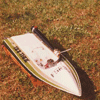 when I travelled to see my cousin - with no anicipation - in the countryside.
He was working on something and he gave me lots of catalogues (Robbe,
Symprop, Multiplex, Graupner). I saw a radio control model for the first
time in my life, and by the time he arrived home that afternoon I was
completely dazzled by it. In the same afternoon we went to the lake and
I was allowed to try the wonder-toy out.
when I travelled to see my cousin - with no anicipation - in the countryside.
He was working on something and he gave me lots of catalogues (Robbe,
Symprop, Multiplex, Graupner). I saw a radio control model for the first
time in my life, and by the time he arrived home that afternoon I was
completely dazzled by it. In the same afternoon we went to the lake and
I was allowed to try the wonder-toy out. 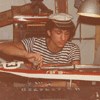 A
week later there was an FSR competition in Szeged (in eastern Hungary)
where I got to learn the depth of the whole thing. It was early in the
morning, there was not much going on, and Istvan introduced me to a
clever young man: "I am Vilmos Kudlik" , he introduced himself
modestly. At that moment I could not even think that I was going to
become one of the constructors of the most famous Graupner Model
Company). This was the legendary M7 Moki 'era' at that time. So I was
pretty much 'infected'! My first model was a smaller sized Kudlik Magic,
for which I managed to get a 2,5 cc Enya engine and a Robbe-Futaba AM
Remote Control with 2 channels, on my first travel to Vienna in 1982.
The model turned out to be very good, and with my cousin's help I
installed a 3.5 cc Webra into it, and thus it seemed to be worth
participating in a FSR competition in Budapest.
A
week later there was an FSR competition in Szeged (in eastern Hungary)
where I got to learn the depth of the whole thing. It was early in the
morning, there was not much going on, and Istvan introduced me to a
clever young man: "I am Vilmos Kudlik" , he introduced himself
modestly. At that moment I could not even think that I was going to
become one of the constructors of the most famous Graupner Model
Company). This was the legendary M7 Moki 'era' at that time. So I was
pretty much 'infected'! My first model was a smaller sized Kudlik Magic,
for which I managed to get a 2,5 cc Enya engine and a Robbe-Futaba AM
Remote Control with 2 channels, on my first travel to Vienna in 1982.
The model turned out to be very good, and with my cousin's help I
installed a 3.5 cc Webra into it, and thus it seemed to be worth
participating in a FSR competition in Budapest.
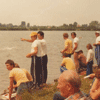
And so the bird takes wings
There was a classic, model building magazine, edited by György Prohaszka
which we read enthusiastically, we also regularly published in later editions
of this magazine. We also had the chance at that time to order such magazines
as the 'Modellbau Heute' from East Germany and the Czech 'Modelar' magazine.
I also frequented the National Technical and Documentation Centre with
a friend of mine, where we looked into a volume of the 'Model Airplane
News' magazine. This is how we were able to follow the national and international
trends. Before that time I had not really started making models seriously,
I did something different; I played soccer for 6 years. It helped me to
play in a team and in front of an audience, I also learned to lose, which
was important too. So, if I wanted to make a joke about it I could say
that later on with modeling it was easier to appear in the newspaper 'National
Sports'(after some weekend games).
Hard working years
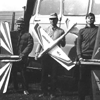 Several years later and after a lot of effort, painful learning and
new model-boats I had my first real success. The first place in the first-level
in FSR 3,5 class; the first National Championship in the FSR 6.5 in 1987,
Several years later and after a lot of effort, painful learning and
new model-boats I had my first real success. The first place in the first-level
in FSR 3,5 class; the first National Championship in the FSR 6.5 in 1987,
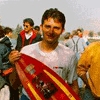 and
the first gold medals in the F1-V European Championship in Malmö
in 1991. After a countless number of working hours spent with constructing
while listening to music and after a lot of practice,I was able to achieve
several national and international successes. During these hard-working
years my younger brother also grew up. He also showed great talent and
together we strived at stubborn, and sometimes almost fanatic but meaningful
activity. At the same time we were also interested in flying and auto-driving,
but they were rather drills to get more routine in constructing, to enlarge
our understanding of the world of form, or simply just for relaxation.
Zoltan is a proud family father today (just like our father was) and one
the most prominent personalities in the Hungarian and International FSR
field. (He is an U.I.M. FSR-3,5 and Naviga FSR-O 3,5 World Champion, also he was a dealer of CMB, Rossi
and Novarossi)
and
the first gold medals in the F1-V European Championship in Malmö
in 1991. After a countless number of working hours spent with constructing
while listening to music and after a lot of practice,I was able to achieve
several national and international successes. During these hard-working
years my younger brother also grew up. He also showed great talent and
together we strived at stubborn, and sometimes almost fanatic but meaningful
activity. At the same time we were also interested in flying and auto-driving,
but they were rather drills to get more routine in constructing, to enlarge
our understanding of the world of form, or simply just for relaxation.
Zoltan is a proud family father today (just like our father was) and one
the most prominent personalities in the Hungarian and International FSR
field. (He is an U.I.M. FSR-3,5 and Naviga FSR-O 3,5 World Champion, also he was a dealer of CMB, Rossi
and Novarossi)
Lights and shadows
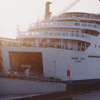 We
were able to get moral and even financial support in the former MHSZ
We
were able to get moral and even financial support in the former MHSZ 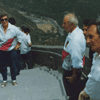 (Hungarian Defense Association for Young People) times, this means we could bus-travel
or fly to several countries in order to represent Hungary. The participation
in these international events gave us the opportunity to develop deep
friendships and to get to know a new way of life,develop a good attitude
and to get some routine. Besides, we always had time to take a look at
the towns we visited and to return home with nice memories and photos
together with the medals. Unfortunately, I had to cope with disappointments
at times, for example when I could only participate in the FSR World Championship
in 1992 in Sweden as an active fan. The reason for that was that at that
time the committee of experts had not decided fairly and so my registration
with the help of my later sponsor was dispatch in too late. Oh yeah, I
also survived earlier a masculine rite of passage, not to mention the
several bathings, of which even the Romans could be envious. Still, I
can consider myself a lucky man, because I was doing something that I
was interested in.
(Hungarian Defense Association for Young People) times, this means we could bus-travel
or fly to several countries in order to represent Hungary. The participation
in these international events gave us the opportunity to develop deep
friendships and to get to know a new way of life,develop a good attitude
and to get some routine. Besides, we always had time to take a look at
the towns we visited and to return home with nice memories and photos
together with the medals. Unfortunately, I had to cope with disappointments
at times, for example when I could only participate in the FSR World Championship
in 1992 in Sweden as an active fan. The reason for that was that at that
time the committee of experts had not decided fairly and so my registration
with the help of my later sponsor was dispatch in too late. Oh yeah, I
also survived earlier a masculine rite of passage, not to mention the
several bathings, of which even the Romans could be envious. Still, I
can consider myself a lucky man, because I was doing something that I
was interested in.
Our club, the BKV MSE led by Laszló Molnár also gave us every possible
support necessary for successful participation. Of course, 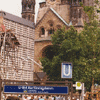 they
knew that not just ricinus-oil but also a good deal of titanium running
in our veins, actually in many of us in the team. Before we organised
the traditional BKV Cup in his memory at centre of Budapest.
they
knew that not just ricinus-oil but also a good deal of titanium running
in our veins, actually in many of us in the team. Before we organised
the traditional BKV Cup in his memory at centre of Budapest.
After the first invitation to Schrems we developed a very friendly relationship
with the Austrian team. This meant meeting these people here and there
later on as well, and these meetings were not only about modelling competitions.
All in all, everybody learnt what a real friendship is like.
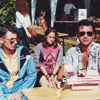 |
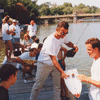 |
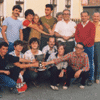 |
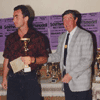 |
Appearings in the Media
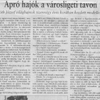
I had the chance to appear in different newspaper and magazine articles
and TV interviews, for example in the live afternoon-program called "Window".
We had to wait backstage and without being told anything (just like before
a race). we had to answer direct questions. I remember how I said good-bye
in the end:
"We are glad to have made model building popular". l guess there
were about 3 million people watching this program. I could also mention
the programme on RTL called " What, how much, for how much".
So there were some challenges, I can tell you!
Sir Player
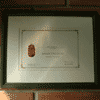
A few years ago we got an invitation from the ministry of the Interior
who -in the company of Pál Schmitt (President of Committee Olympic) - gave
us a small commemorative item at a reception party. It was a nice Seiko standing watch which
rings every quarter of an hour the Big Ben Westminster, accompanied by a unique certificate. I
think this is the thing of which I am the most modest because we received
this kind of acknowledgement for our work and maybe for our culture-
Double or quits
It was in 1993 when I prepared with full steam for the big challenge,
the F1-V World Championship in Wendlingen-Germany. Perhaps we would succeed
in getting a grip on the Chinese up. In category 15 I built two new models
to double my chances, so to say. I built a CMB 13 cc engine into a light
and smaller size 6.5 hull; i.e. a newly improved 15 cc Idro (sponsored
by Mr. Gualtiero Picco) one came into a well tried out 15 hull, but apparently a
more robust plant than the previous P 80. The first trials did not show
much hope but the later ones did. Then summer arrived with a lot of sunshine
and the level of the water in the lake where we trained decreased. It
almost got under the critical half meter.
As we all know, each coin has two sides, and as always, we came and the rocket buried itself after a few routine circles in the mud. We had to go in and get it out, then go home, take it apart, clean the engine, check it and then put it together again. There is also no other lake and the competition approaches. Then starting it all over again, escaping into victory, as it were. In the National Championship prior to the World Championship we still could come up with an encouraging result but under the next and last tries it turned out that the Piccos crankcase cracked and we could not be welded.
So I called to Stuttgart confirming that we will go to the World Championship and we would need a spare-part. "Kein Problem, es geht ('Not a problem, it's all right')." Our way led directly to the Gundert. After repeated tunings and constructing we tried to waken up the lost hopes now on the venue of the race. Training also at dawn (like at home but because of the lack of wind) but this is just "like water off a ducks back". The expected result did not come. At the last round a light wind was blowing and the "She" looked encouraging.
Obviously,
this was the time when we thought, we had to pull ourselves together. I
truly feel that it is a miracle that I could take the first 5 buoys
literally 'sharp and veryclose'. After the first curve on the right the
"balanstic" - which already has seen better and worse times like
katapult flying 4-5 meters then disappearing with a 'knife-figure' in
the rippling, crystal-clear water. After a short break when the red
hull emerged again, the audience started to clap. I felt came little
satisfaction that, at least I could third which put a smile on my face.
While I was on my way to the depot where we overviewed the situation ,
my future colleague Peter Schmidt (he was before also the leader of M
section of 'NAVIGA' i.e. International Boat Organisation) came up to me
and said: "I am glad to have seen you competing! Would you feel like
working for Graupner?"
Herr Tóth-
Year and a half was a short time, but it would take too long to talk about
it. 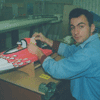 One
thing is for sure, they treated me as an true equal colleague on equal
terms.
One
thing is for sure, they treated me as an true equal colleague on equal
terms.
My first job was the building of an Azimut Atlantic Challenger sample-kit.
The result was really nice. After that I got an independent and rather
complex task, l had to construct a Mega Dragstar Mono-2 racing boat into
a popular series. With Egon Will's unselfish help (the floating part of
the boat comes originally from him) I could find the necessary sizes and
it behaved well actually in the first competitions. 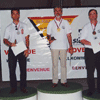 Considering
that the next World Championship was in 1995, my brother also felt like
building such a cool speedy machine, which was quite unique class here at that time.
He improved it at home and I developed it in Germany on this ominous lake
in Wendlingen. Sometimes we shared thoughts and when we had the opportunity
to train at home we ran almost always side by side together. And then
back to the quiet West...
Considering
that the next World Championship was in 1995, my brother also felt like
building such a cool speedy machine, which was quite unique class here at that time.
He improved it at home and I developed it in Germany on this ominous lake
in Wendlingen. Sometimes we shared thoughts and when we had the opportunity
to train at home we ran almost always side by side together. And then
back to the quiet West...
The time for actions came and maybe with God's help I can succeed in finishing
the race on the windy Lake at a crazy speed (two years later I could repeat
it at the Mono-3 with the prototype of the Triton, where Egon was luckier
and over took me by two seconds.) I admit that I had been programmed for
it a long time ago and my dream came true. I became World Champion.
But because the steamboat keeps rolling
Another candle on the pink cake was - so to say - when l had to rescue
our "steamboat" called Daytona Beach out of the ice-cold river
Neckar before the big toy-exhibition in Nuernberg during a video recording.
"This website is dedicated to my living memory of my Dad whose presence
has always been - and so will be - the power of inspiration for me."
2001.
Print